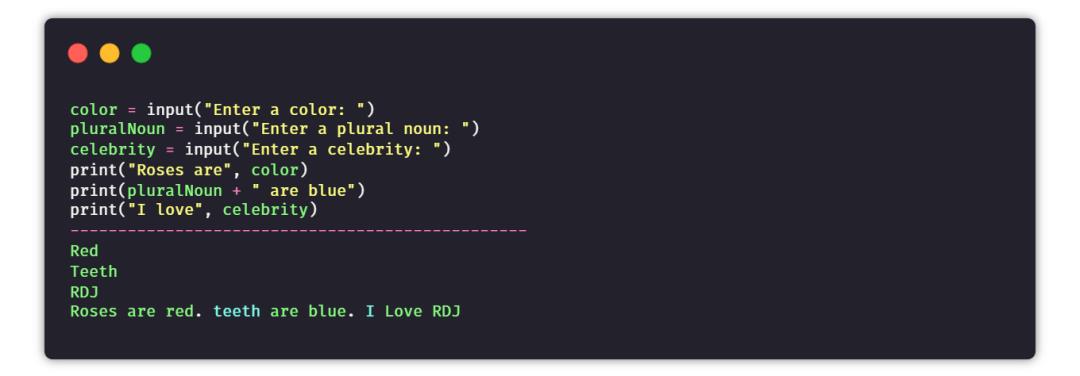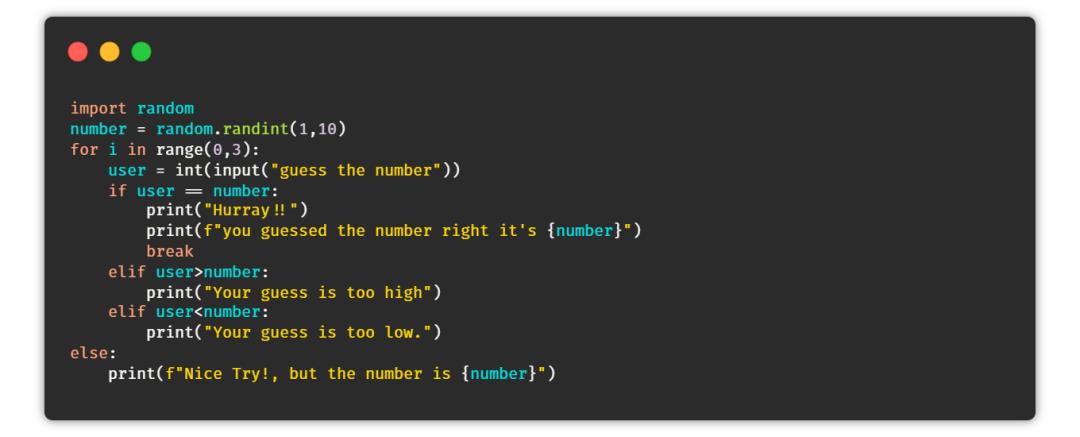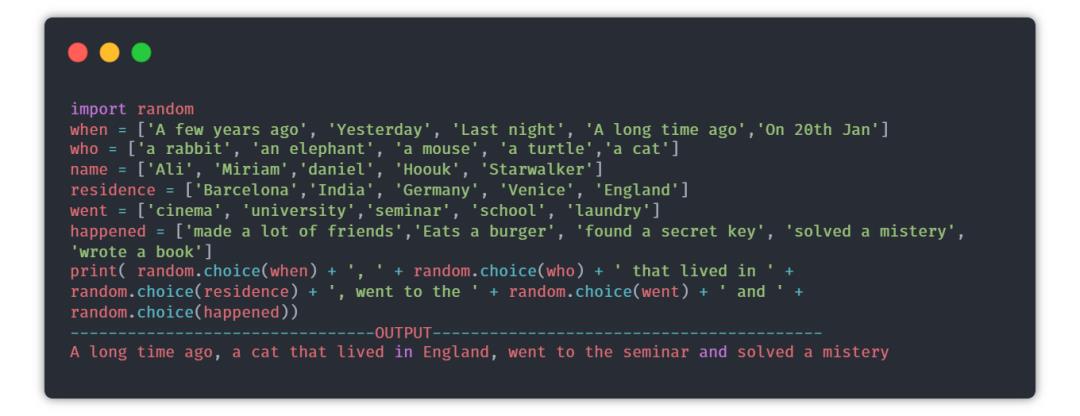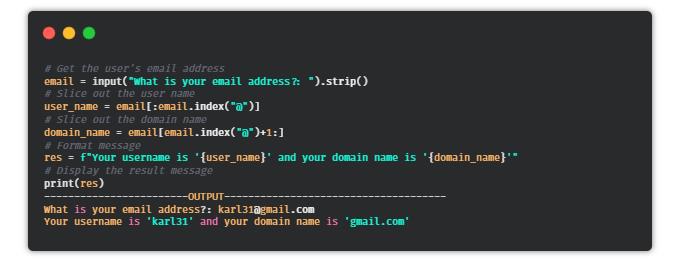学习练手的22个Python迷你程序
Posted K'illCode
tags:
篇首语:本文由小常识网(cha138.com)小编为大家整理,主要介绍了学习练手的22个Python迷你程序相关的知识,希望对你有一定的参考价值。
① 骰子模拟器
目的:创建一个程序来模拟掷骰子。
提示:当用户询问时,使用random模块生成一个1到6之间的数字。

② 石头剪刀布游戏
目标:创建一个命令行游戏,游戏者可以在石头、剪刀和布之间进行选择,与计算机PK。如果游戏者赢了,得分就会添加,直到结束游戏时,最终的分数会展示给游戏者。
提示:接收游戏者的选择,并且与计算机的选择进行比较。计算机的选择是从选择列表中随机选取的。如果游戏者获胜,则增加1分。
import random
choices = ["Rock", "Paper", "Scissors"]
computer = random.choice(choices)
player = False
cpu_score = 0
player_score = 0
while True:
player = input("Rock, Paper or Scissors?").capitalize()
# 判断游戏者和电脑的选择
if player == computer:
print("Tie!")
elif player == "Rock":
if computer == "Paper":
print("You lose!", computer, "covers", player)
cpu_score+=1
else:
print("You win!", player, "smashes", computer)
player_score+=1
elif player == "Paper":
if computer == "Scissors":
print("You lose!", computer, "cut", player)
cpu_score+=1
else:
print("You win!", player, "covers", computer)
player_score+=1
elif player == "Scissors":
if computer == "Rock":
print("You lose...", computer, "smashes", player)
cpu_score+=1
else:
print("You win!", player, "cut", computer)
player_score+=1
elif player=='E':
print("Final Scores:")
print(f"CPU:{cpu_score}")
print(f"Plaer:{player_score}")
break
else:
print("That's not a valid play. Check your spelling!")
computer = random.choice(choices)
③ 随机密码生成器
目标:创建一个程序,可指定密码长度,生成一串随机密码。
提示:创建一个数字+大写字母+小写字母+特殊字符的字符串。根据设定的密码长度随机生成一串密码。

④ 句子生成器
目的:通过用户提供的输入,来生成随机且唯一的句子。
提示:以用户输入的名词、代词、形容词等作为输入,然后将所有数据添加到句子中,并将其组合返回。

⑤ 猜数字游戏
目的:在这个游戏中,任务是创建一个脚本,能够在一个范围内生成一个随机数。如果用户在三次机会中猜对了数字,那么用户赢得游戏,否则用户输。
提示:生成一个随机数,然后使用循环给用户三次猜测机会,根据用户的猜测打印最终的结果。

⑥ 故事生成器
目的:每次用户运行程序时,都会生成一个随机的故事。
提示:random模块可以用来选择故事的随机部分,内容来自每个列表里。

⑦ 邮件地址切片器
目的:编写一个Python脚本,可以从邮件地址中获取用户名和域名。
提示:使用@作为分隔符,将地址分为分为两个字符串。

⑧ 自动发送邮件
目的:编写一个Python脚本,可以使用这个脚本发送电子邮件。
提示:email库可用于发送电子邮件。
import smtplib
from email.message import EmailMessage
email = EmailMessage() ## Creating a object for EmailMessage
email['from'] = 'xyz name' ## Person who is sending
email['to'] = 'xyz id' ## Whom we are sending
email['subject'] = 'xyz subject' ## Subject of email
email.set_content("Xyz content of email") ## content of email
with smtlib.SMTP(host='smtp.gmail.com',port=587)as smtp:
## sending request to server
smtp.ehlo() ## server object
smtp.starttls() ## used to send data between server and client
smtp.login("email_id","Password") ## login id and password of gmail
smtp.send_message(email) ## Sending email
print("email send") ## Printing success message
⑨ 缩写词
目的:编写一个Python脚本,从给定的句子生成一个缩写词。
提示:你可以通过拆分和索引来获取第一个单词,然后将其组合。

⑩ 文字冒险游戏
目的:编写一个有趣的Python脚本,通过为路径选择不同的选项让用户进行有趣的冒险。

⑪ Hangman
目的:创建一个简单的命令行hangman游戏。
提示:创建一个密码词的列表并随机选择一个单词。现在将每个单词用下划线“_”表示,给用户提供猜单词的机会,如果用户猜对了单词,则将“_”用单词替换。
import time
import random
name = input("What is your name? ")
print ("Hello, " + name, "Time to play hangman!")
time.sleep(1)
print ("Start guessing...\\n")
time.sleep(0.5)
## A List Of Secret Words
words = ['python','programming','treasure','creative','medium','horror']
word = random.choice(words)
guesses = ''
turns = 5
while turns > 0:
failed = 0
for char in word:
if char in guesses:
print (char,end="")
else:
print ("_",end=""),
failed += 1
if failed == 0:
print ("\\nYou won")
break
guess = input("\\nguess a character:")
guesses += guess
if guess not in word:
turns -= 1
print("\\nWrong")
print("\\nYou have", + turns, 'more guesses')
if turns == 0:
print ("\\nYou Lose")
⑫ 闹钟
目的:编写一个创建闹钟的Python脚本。
提示:你可以使用date-time模块创建闹钟,以及playsound库播放声音。
from datetime import datetime
from playsound import playsound
alarm_time = input("Enter the time of alarm to be set:HH:MM:SS\\n")
alarm_hour=alarm_time[0:2]
alarm_minute=alarm_time[3:5]
alarm_seconds=alarm_time[6:8]
alarm_period = alarm_time[9:11].upper()
print("Setting up alarm..")
while True:
now = datetime.now()
current_hour = now.strftime("%I")
current_minute = now.strftime("%M")
current_seconds = now.strftime("%S")
current_period = now.strftime("%p")
if(alarm_period==current_period):
if(alarm_hour==current_hour):
if(alarm_minute==current_minute):
if(alarm_seconds==current_seconds):
print("Wake Up!")
playsound('audio.mp3') ## download the alarm sound from link
break
⑬ 有声读物
目的:编写一个Python脚本,用于将Pdf文件转换为有声读物。
提示:借助pyttsx3库将文本转换为语音。
安装:pyttsx3,PyPDF2

⑭ 天气应用
目的:编写一个Python脚本,接收城市名称并使用爬虫获取该城市的天气信息。
提示:你可以使用Beautifulsoup和requests库直接从谷歌主页爬取数据。
安装:requests,BeautifulSoup
from bs4 import BeautifulSoup
import requests
headers = {'User-Agent': 'Mozilla/5.0 (Windows NT 10.0; Win64; x64) AppleWebKit/537.36 (Khtml, like Gecko) Chrome/58.0.3029.110 Safari/537.3'}
def weather(city):
city=city.replace(" ","+")
res = requests.get(f'https://www.google.com/search?q={city}&oq={city}&aqs=chrome.0.35i39l2j0l4j46j69i60.6128j1j7&sourceid=chrome&ie=UTF-8',headers=headers)
print("Searching in google......\\n")
soup = BeautifulSoup(res.text,'html.parser')
location = soup.select('#wob_loc')[0].getText().strip()
time = soup.select('#wob_dts')[0].getText().strip()
info = soup.select('#wob_dc')[0].getText().strip()
weather = soup.select('#wob_tm')[0].getText().strip()
print(location)
print(time)
print(info)
print(weather+"°C")
print("enter the city name")
city=input()
city=city+" weather"
weather(city)
⑮ 人脸检测
目的:编写一个Python脚本,可以检测图像中的人脸,并将所有的人脸保存在一个文件夹中。
提示:可以使用haar级联分类器对人脸进行检测。它返回的人脸坐标信息,可以保存在一个文件中。
安装:OpenCV。
下载:haarcascade_frontalface_default.xml
https://raw.githubusercontent.com/opencv/opencv/master/data/haarcascades/haarcascade_frontalface_default.xml
import cv2
# Load the cascade
face_cascade = cv2.CascadeClassifier('haarcascade_frontalface_default.xml')
# Read the input image
img = cv2.imread('images/img0.jpg')
# Convert into grayscale
gray = cv2.cvtColor(img, cv2.COLOR_BGR2GRAY)
# Detect faces
faces = face_cascade.detectMultiScale(gray, 1.3, 4)
# Draw rectangle around the faces
for (x, y, w, h) in faces:
cv2.rectangle(img, (x, y), (x+w, y+h), (255, 0, 0), 2)
crop_face = img[y:y + h, x:x + w]
cv2.imwrite(str(w) + str(h) + '_faces.jpg', crop_face)
# Display the output
cv2.imshow('img', img)
cv2.imshow("imgcropped",crop_face)
cv2.waitKey()
⑯ 提醒应用
目的:创建一个提醒应用程序,在特定的时间提醒你做一些事情(桌面通知)。
提示:Time模块可以用来跟踪提醒时间,toastnotifier库可以用来显示桌面通知。
安装:win10toast
from win10toast import ToastNotifier
import time
toaster = ToastNotifier()
try:
print("Title of reminder")
header = input()
print("Message of reminder")
text = input()
print("In how many minutes?")
time_min = input()
time_min=float(time_min)
except:
header = input("Title of reminder\\n")
text = input("Message of remindar\\n")
time_min=float(input("In how many minutes?\\n"))
time_min = time_min * 60
print("Setting up reminder..")
time.sleep(2)
print("all set!")
time.sleep(time_min)
toaster.show_toast(f"{header}",
f"{text}",
duration=10,
threaded=True)
while toaster.notification_active(): time.sleep(0.005)
⑰ 维基百科文章摘要
目的:使用一种简单的方法从用户提供的文章链接中生成摘要。
提示:你可以使用爬虫获取文章数据,通过提取生成摘要。
from bs4 import BeautifulSoup
import re
import requests
import heapq
from nltk.tokenize import sent_tokenize,word_tokenize
from nltk.corpus import stopwords
url = str(input("Paste the url"\\n"))
num = int(input("Enter the Number of Sentence you want in the summary"))
num = int(num)
headers = {'User-Agent': 'Mozilla/5.0 (Windows NT 10.0; Win64; x64) AppleWebKit/537.36 (KHTML, like Gecko) Chrome/58.0.3029.110 Safari/537.3'}
#url = str(input("Paste the url......."))
res = requests.get(url,headers=headers)
summary = ""
soup = BeautifulSoup(res.text,'html.parser')
content = soup.findAll("p")
for text in content:
summary +=text.text
def clean(text):
text = re.sub(r"\\[[0-9]*\\]"," ",text)
text = text.lower()
text = re.sub(r'\\s+'," ",text)
text = re.sub(r","," ",text)
return text
summary = clean(summary)
print("Getting the data......\\n")
##Tokenixing
sent_tokens = sent_tokenize(summary)
summary = re.sub(r"[^a-zA-z]"," ",summary)
word_tokens = word_tokenize(summary)
## Removing Stop words
word_frequency = {}
stopwords = set(stopwords.words("english"))
for word in word_tokens:
if word not in stopwords:
if word not in word_frequency.keys():
word_frequency[word]=1
else:
word_frequency[word] +=1
maximum_frequency = max(word_frequency.values())
print(maximum_frequency)
for word in word_frequency.keys():
word_frequency[word] = (word_frequency[word]/maximum_frequency)
print(word_frequency)
sentences_score = {}
for sentence in sent_tokens:
for word in word_tokenize(sentence):
if word in word_frequency.keys():
if (len(sentence.split(" "))) <30:
if sentence not in sentences_score.keys():
sentences_score[sentence] = word_frequency[word]
else:
sentences_score[sentence] += word_frequency[word]
print(max(sentences_score.values()))
def get_key(val):
for key, value in sentences_score.items():
if val == value:
return key
key = get_key(max(sentences_score.values()))
print(key+"\\n")
print(sentences_score)
summary = heapq.nlargest(num,sentences_score,key=sentences_score.get)
print(" ".join(summary))
summary = " ".join(summary)
⑱ 获取谷歌搜索结果
目的:创建一个脚本,可以根据查询条件从谷歌搜索获取数据。
from bs4 import BeautifulSoup
import requests
headers = {'User-Agent': 'Mozilla/5.0 (Windows NT 10.0; Win64; x64) AppleWebKit/537.36 (KHTML, like Gecko) Chrome/58.0.3029.110 Safari/537.3'}
def google(query):
query = query.replace(" ","+")
try:
url = f'https://www.google.com/search?q={query}&oq={query}&aqs=chrome..69i57j46j69i59j35i39j0j46j0l2.4948j0j7&sourceid=chrome&ie=UTF-8'
res = requests.get(url,headers=headers)
soup = BeautifulSoup(res.text,'html.parser')
except:
print("Make sure you have a internet connection")
try:
try:
ans = soup.select('.RqBzHd')[0].getText().strip()
except:
try:
title=soup.select('.AZCkJd')[0].getText().strip()
try:
ans=soup.select('.e24Kjd')[0].getText().strip()
except:
ans=""
ans=f'{title}\\n{ans}'
except:
try:
ans=soup.select('.hgKElc')[0].getText().strip()
except:
ans=soup.select('.kno-rdesc span')[0].getText().strip()
except:
ans = "can't find on google"
return ans
result = google(str(input("Query\\n")))
print(result)
获取结果如下。

⑲ 货币换算器
目的:编写一个Python脚本,可以将一种货币转换为其他用户选择的货币。
提示:使用Python中的API,或者通过forex-python模块来获取实时的货币汇率。
安装:forex-python

⑳ 键盘记录器
目的:编写一个Python脚本,将用户按下的所有键保存在一个文本文件中。
提示:pynput是Python中的一个库,用于控制键盘和鼠标的移动,它也可以用于制作键盘记录器。简单地读取用户按下的键,并在一定数量的键后将它们保存在一个文本文件中。
from pynput.keyboard import Key, Controller,Listener
import time
keyboard = Controller()
keys=[]
def on_press(key):
global keys
#keys.append(str(key).replace("'",""))
string = str(key).replace("'","")
keys.append(string)
main_string = "".join(keys)
print(main_string)
if len(main_string)>15:
with open('keys.txt', 'a') as f:
f.write(main_string)
keys= []
def on_release(key):
if key == Key.esc:
return False
with listener(on_press=on_press,on_release=on_release) as listener:
listener.join()
㉑ 文章朗读器
目的:编写一个Python脚本,自动从提供的链接读取文章。
import pyttsx3
import requests
from bs4 import BeautifulSoup
url = str(input("Paste article url\\n"))
def content(url):
res = requests.get(url)
soup = BeautifulSoup(res.text,'html.parser')
articles = []
for i in range(len(soup.select('.p'))):
article = soup.select('.p')[i].getText().strip()
articles.append(article)
contents = " ".join(articles)
return contents
engine = pyttsx3.init('sapi5')
voices = engine.getProperty('voices')
engine.setProperty('voice', voices[0].id)
def speak(audio):
engine.say(audio)
engine.runAndWait()
contents = content(url)
## print(contents) ## In case you want to see the content
#engine.save_to_file
#engine.runAndWait() ## In case if you want to save the article as a audio file
㉒ 短网址生成器
目的:编写一个Python脚本,使用API缩短给定的URL。
from __future__ import with_statement
import contextlib
try:
from urllib.parse import urlencode
except ImportError:
from urllib import urlencode
try:
from urllib.request import urlopen
except ImportError:
from urllib2 import urlopen
import sys
def make_tiny(url):
request_url = ('http://tinyurl.com/api-create.php?' +
urlencode({'url':url}))
with contextlib.closing(urlopen(request_url)) as response:
return response.read().decode('utf-8')
def main():
for tinyurl in map(make_tiny, sys.argv[1:]):
print(tinyurl)
if __name__ == '__main__':
main()
-----------------------------OUTPUT------------------------
python url_shortener.py https://www.wikipedia.org/
https://tinyurl.com/buf3qt3
以上就是今天分享的内容。
项目中有些需要适当调整。比如自动发送邮件,可以选择使用QQ邮箱;查询天气信息也可使用国内一些免费的API;维基百科可以对应百度百科;谷歌搜索可以对应百度搜索等等。
这些都是大伙在运行过程中需要注意的。
以上是关于学习练手的22个Python迷你程序的主要内容,如果未能解决你的问题,请参考以下文章